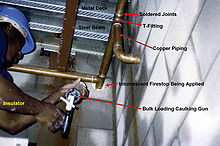Plumbing



Plumbing, from the Latin plumbum for lead, is the skilled trade of working with pipes, tubing and plumbing fixtures for drinking water systems and the drainage of waste. A plumber is someone who installs or repairs piping systems, plumbing fixtures and equipment such as water heaters. The plumbing industry is a basic and substantial part of every developed economy due to the need for clean water, and proper collection and transport of wastes.[1]
Plumbing also refers to a system of pipes and fixtures installed in a building for the distribution of potable water and the removal of waterborne wastes. Plumbing is usually distinguished from water and sewage systems, in that a plumbing system serves one building, while water and sewage systems serve a group of buildings or a city.
History
Standardized earthenware plumbing pipes with broad flanges making use of asphalt for preventing leakages appeared in the urban settlements of the Indus Valley Civilization by 2700 B.C.[2] Plumbing originated during the ancient civilizations such as the Greek, Roman, Persian, Indian, and Chinese civilizations as they developed public baths and needed to provide potable water, and drainage of wastes. Improvement in plumbing systems was very slow, with virtually no progress made from the time of the Roman system of aqueducts and lead pipes until the 19th century. Eventually the development of separate, underground water and sewage systems eliminated open sewage ditches and cesspools.
Materials
Water systems of ancient times relied on gravity for the supply of water, using pipes or channels usually made of clay, lead or stone. Present-day water-supply systems use a network of high-pressure pumps, and pipes are now made of copper,[3] brass, plastic, steel, or other nontoxic material. Present-day drain and vent lines are made of plastic, steel, cast-iron, and lead. Lead is not used in modern water-supply piping due to its toxicity.[4][5]
The 'straight' sections of plumbing systems are of pipe or tube. A pipe is typically formed via casting or welding, where a tube is made through extrusion. Pipe normally has thicker walls and may be threaded or welded, where tubing is thinner-walled and requires special joining techniques such as 'brazing', 'compression fitting', 'crimping', or for plastics, 'solvent welding'.
Fittings and valves
In addition to the straight pipe or tubing, many fittings are required in plumbing systems, such as valves, elbows, tees, and unions. The piping and plumbing fittings and valves articles discuss them further.
Fixtures
Plumbing fixtures are designed for the end-users. Some examples of fixtures include Water Closets (also known as toilets), urinals, bidets, showers, bathtubs, utility and kitchen sinks, drinking fountains, ice makers, humidifiers, air washers, fountains, and eye wash stations
Equipment
Plumbing equipment, not present in all systems, include, for example, water meters, pumps, expansion tanks, backflow preventers, filters, water softeners, water heaters, heat exchangers, gauges, and control systems.
Systems
The major categories of plumbing systems or subsystems are:
- Potable cold and hot water supply
- Traps, drains, and vents
- Septic systems
- Rainwater, surface, and subsurface water drainage
- Fuel gas piping
For their environmental benefit and sizable energy savings hot water heat recycling units are growing in use throughout the residential building sectors. Further ecological concern has seen increasing interest in gray-water recovery and treatment systems.
Firestopping

Firestopping is required where mechanical penetrants traverse fire-resistance rated wall and floor assemblies, or membranes thereof. This work is usually done worldwide by the insulation trade and/or specialty firestop sub-contractors.
Regulation
Much of the plumbing work in populated areas (cities, towns, etc...) is regulated by government or quasi-government agencies due to the direct impact on the public's health, safety, and welfare. Plumbing installation and repair work on residences and other buildings generally must be done according to plumbing and building codes to protect the inhabitants of the buildings and to ensure safe, quality construction to future buyers. If permits are required for work, plumbing contractors typically secure them from the authorities on behalf of home or building owners. Unusually, in the United Kingdom the plumbing trade still remains virtually ungoverned; there are no systems in place to monitor or control the activities of unqualified plumbers or those home owners who choose to undertake installation and maintenance works themselves, despite the health and safety issues which arise from such works when they are undertaken incorrectly - see Health Aspects of Plumbing (HAP) published jointly by the World Health Organisation (WHO)[1] and the World Plumbing Council (WPC) [2]. WPC has subsequently appointed a representative to the World Health Organisation to take forward various projects related to Health Aspects of Plumbing.[3]. Furthermore, despite having in place an infrastructure dedicated to formally training plumbers and various statutes, regulations and bye-laws designed to dictate and control how and in what manner plumbing works are undertaken, there is nothing to stop anyone without any training whatsoever working as a plumber, safe in the knowledge that it is unlikely that their lack of technical know-how will ever be found out. Such people are commonly referred to as "cowboys".
See also
- Water pipe
- Heat pipe
- Firestop
- Passive fire protection
- Active fire protection
- Hot water heat recycling
- World Plumbing Council
